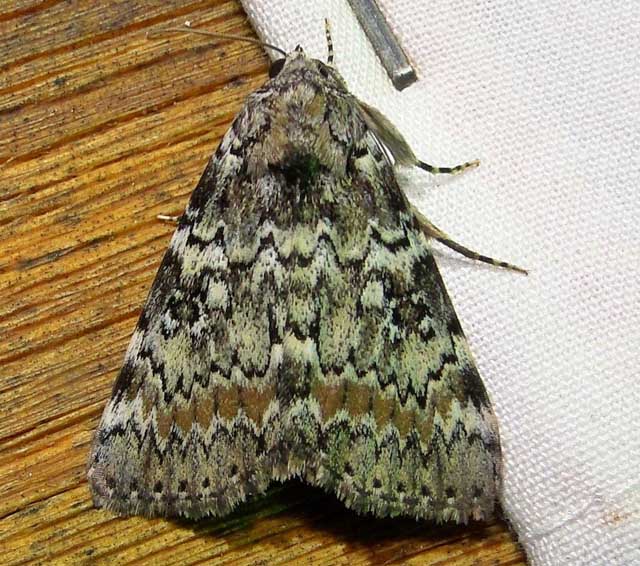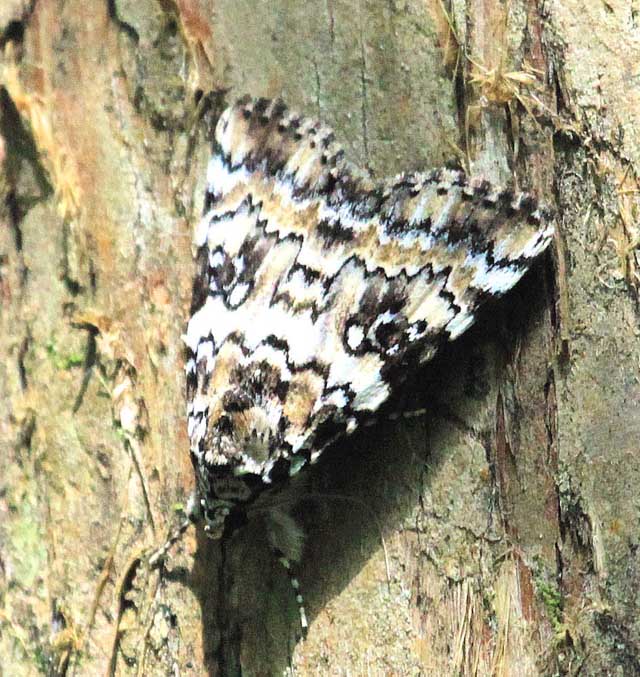Catocala connubialis
|
|
Updated as per personal communication with Ken Allen (C. connubialis, Hillsborough Co., May 10, 2010): May 11, 2010
Updated as per personal communication with Dave Small (Athol, Worcester County, Connecticut, July 21, 2011); July 25, 2011
|
Catocala connubialis
kah-TOCK-uh-lahmmkon-NEW-bee-al-is
Guenee, 1852

Catocala connubialis form "sancta",
courtesy of Leroy Simon, Florida
This site has been created by
Bill Oehlke at oehlkew@islandtelecom.com
Comments, suggestions and/or additional information are welcomed by Bill.
| TAXONOMY:
Superfamily: Noctuoidea
Family: Noctuidae
Group: Noctuinina
Subfamily: Catocalinae
Genus: Catocala, Schrank, 1802
| |
MIDI MUSIC
"Moon River"
copyright C. Odenkirk
MIDI CITYON.OFF
<bgsound src="moon.mid" LOOP=FOREVER>
|
DISTRIBUTION:
Catocala connubialis, the Connubial
Underwing, (wingspan: 37-47mm), flies from Ontario to Prince Edward
Island, including
Quebec,
New Brunswick and
Nova Scotia
in Canada, south to Florida (as early as May 10) and west to Texas (as early as May
25) and Oklahoma and
Missouri.
It has also been reported in
Arkansas,
Connecticut,
District of Columbia,
Georgia,
Illinois,
Indiana,
Kansas,
Kentucky,
Louisiana,
Maine,
Maryland,
Massachusetts,
Michigan,
Mississippi,
Nebraska,
New Hampshire,
New Jersey,
New York,
North Carolina,
Ohio,
Pennsylvania,
Rhode Island,
South Carolina,
Tennessee,
Virginia,
West Virginia and
Wisconsin.

Catocala connubialis, Athol, Worcester County, Massachusetts,
July 21, 2011, courtesy of Dave Small.
The forewing is highly variable and there are
several different forms:
"sancta" Hulst (bottom) is the typical form and has forewings with
white ground colour and sharply contrasting black lines and markings.
There is also brown shading between post medial and subterminal lines;
"cordelia" H. Edwards is coloured as above but markings are faint;
"pulverulenta" (top) Brower has grey-green forewings with faint
markings, sometimes none;
"broweri" Muller is the melanic form with forewings that are dark
green, almost black.
The hindwing has a separate anal spot and the outer band ends with a
straight cut. The white outer fringe at the hindwing apex is distinct
and slightly more advanced than the yellow-orange inner fringe.
The remaining fringe is pale yellow-orange and heavily barred.
Trio courtesy of James K. Adams. |
 |
In all the images that I have seen, the forewings provide
some distinguishing characters.

Catocala connubialis, Hillsborough County, Florida,
May 10, 2010, courtesy of Ken Allen.
The dark distinct am line consists of four relatively wide, blunt notches, the
smallest first one, bordered by the costa, the last one bordered
by the inner margin, the two internal ones much wider.
There is a
suffusion of darker scales in the basal area inside the outline of
grey-white scales on either side of this line.
The sub-reniform spot is distinct and lighter than surrounding areas,
which also tend to be light in colour.
The distinct pm line has one noticeably wider, blunter "tooth" one
notch up from the inner margin.

Catocala connubialis, variation, Florida, courtesy of Leroy
Simon.
FLIGHT TIMES AND PREFERRED FOOD PLANTS:
Catocala connubialis are usually on the wing from May (Florida-Texas) and June to
early September in more northerly locales.
The Catocala connubialis caterpillar shows a preference
for oaks, particularly red oak.
ECLOSION:Adults eclose from pupae at soil surface.
SCENTING AND MATING:Catocala connubialis females
emit an airbourne pheromone and males use their antennae to track the
scent plume.

Catocala connubialis form "sancta",
courtesy of Leroy Simon, Florida
EGGS, CATERPILLARS, COCOONS AND PUPAE:Eggs are deposited
on tree bark in the fall and hatch the following spring.
 Catocala connubialis
courtesy of David Wagner.
Larval Food Plants
Listed below are primary food plant(s) and alternate food plants.
It is hoped that this alphabetical listing followed by the common
name of the foodplant will prove useful. The list is not exhaustive,
although some species seem very host specific.
Experimenting with closely related foodplants is worthwhile.
Cephalanthus occidentalis.......
Melia azedarach
Quercus rubra
|
Buttonbush
Chinaberry
Northern red oak
|
Return to Main Index
This page is brought to you by
Bill Oehlke and the
WLSS. Pages are on space rented from Bizland. If you would like
to become a "Patron of the Sphingidae/Catocala Sites",
contact Bill.
Please send sightings/images to Bill. I will do my best to respond to
requests for identification help.
| 





